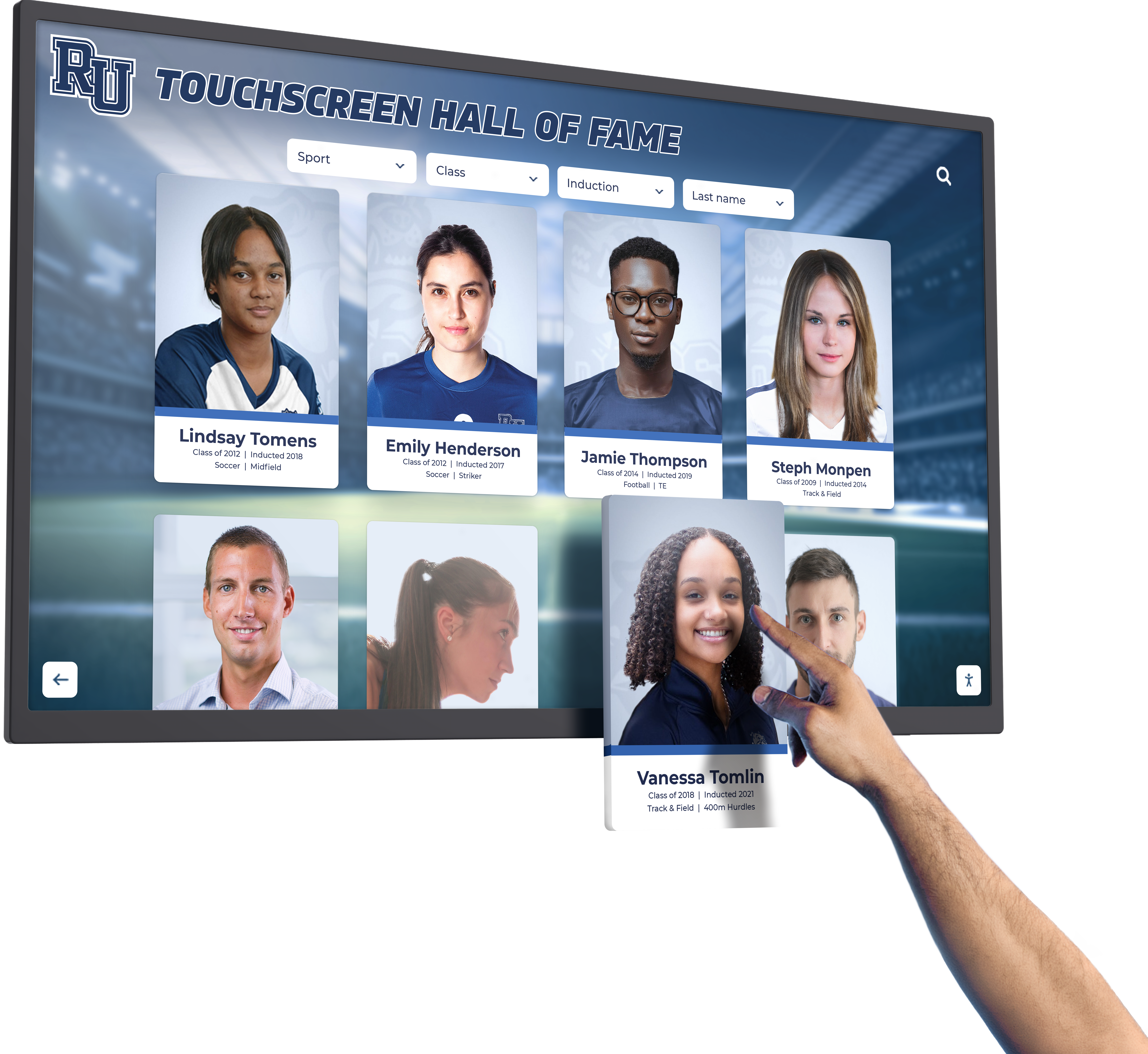Walk into any successful high school gymnasium, and you’ll immediately see the evidence of athletic excellence: championship banners hanging from the rafters, displaying years of hard-fought victories, tournament titles, and conference championships. These banners represent countless hours of practice, moments of triumph, and communities united in celebration. Yet despite their prominence, traditional championship banners face significant limitations that prevent schools from fully leveraging these achievements for recognition, recruitment, and community engagement.
Digital banner recognition solves the fundamental challenges facing traditional championship displays by transforming static banners into interactive, searchable, and comprehensive recognition systems. Through touchscreen displays and digital platforms, schools can showcase every championship detail—complete rosters, game statistics, championship game highlights, team photos, and compelling stories behind each banner—creating engagement opportunities that traditional fabric banners simply cannot provide.
Whether you’re an athletic director managing limited ceiling space for new banners, a principal seeking to maximize the inspirational value of championship recognition, or a facilities coordinator exploring modernization options, this comprehensive guide explores how digital banner recognition strategies help schools celebrate athletic excellence more effectively while addressing the practical limitations of traditional banner displays.
Understanding the Limitations of Traditional Championship Banners
Traditional championship banners have served schools well for decades, providing visible, permanent recognition of athletic achievement. However, these familiar fabric displays come with inherent constraints that limit their effectiveness in modern educational environments.
Physical Space Constraints
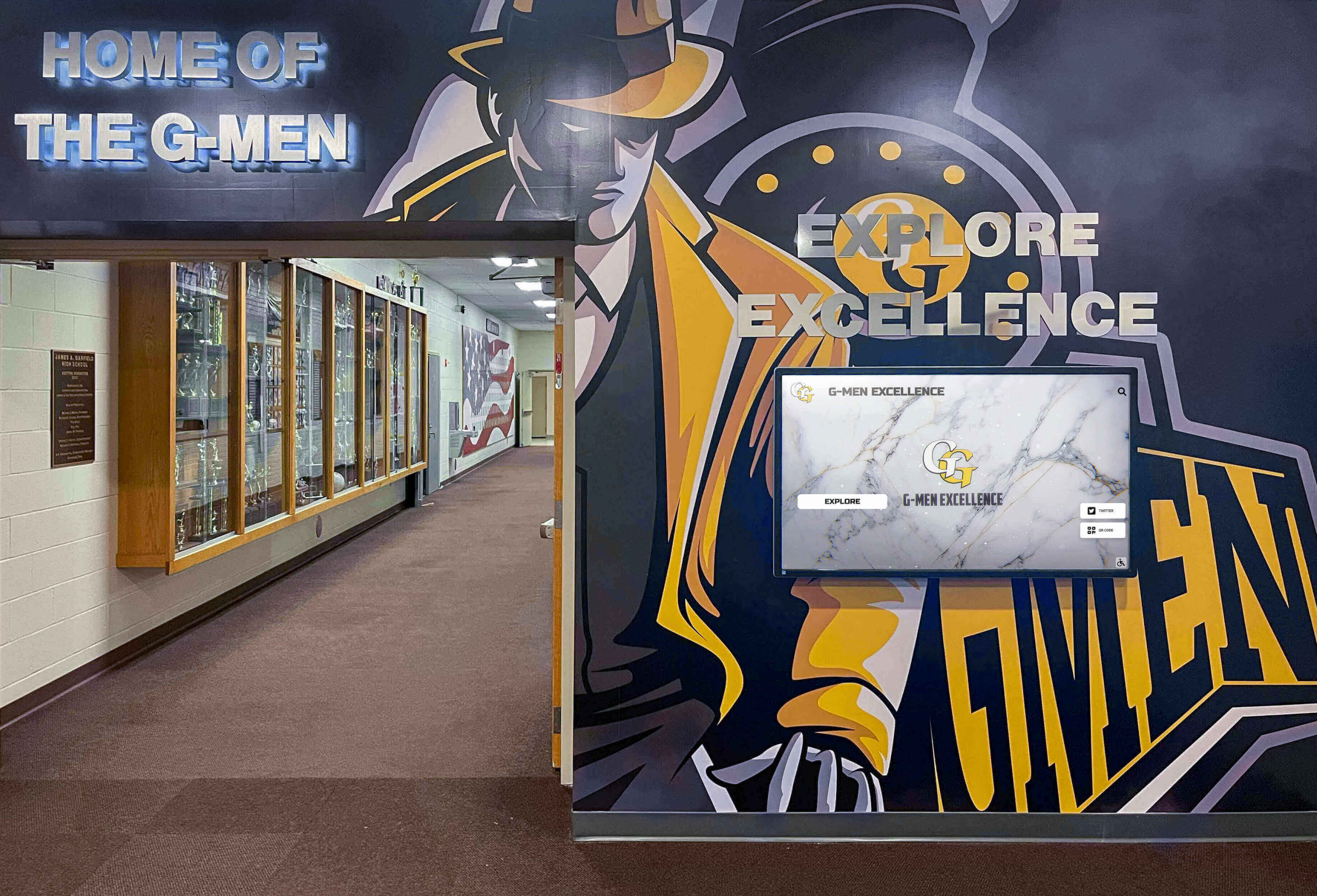
The most obvious limitation facing championship banner programs is simply running out of space. Gymnasium ceilings offer finite hanging capacity, and successful athletic programs generate new championships faster than hanging space becomes available. Schools face difficult decisions about which achievements deserve banner recognition and which teams, despite championship success, don’t receive this honor due to space limitations.
This constraint forces athletic directors to make uncomfortable choices. Does a recent conference championship deserve banner space when it means removing an older state championship? Should multiple banners from the same sport in consecutive years each receive recognition, or should one banner represent the entire era? These questions have no satisfying answers when physical space determines recognition policy rather than achievement significance.
Many programs resort to creating increasingly smaller banners to fit more championships in available space, but this approach diminishes visual impact and makes individual achievements less distinguishable from viewing distances. Others implement rotating displays, periodically removing and storing older banners—but this solution means that significant achievements spend most of their existence invisible to current students and visitors.
Limited Information Capacity
Even when space exists for championship banners, the information they can display remains severely constrained. A typical championship banner includes the sport, year, and achievement level (conference, state, national)—perhaps 10-15 words total. This minimal information fails to capture the complete story behind championship seasons.
Viewers see that the basketball team won a state championship in 2015, but they don’t know who played on that team, what the final record was, who coached the team, or what made that season special. The roster of athletes who earned the championship remains unrecognized. The championship game score and opponent are unknown. The journey through playoffs that led to the title stays untold.
This information limitation particularly affects alumni engagement. Alumni visiting campus might see championship banners from their competitive years but cannot easily determine if they were part of those championship teams. Without detailed information, these banners function as general program recognition rather than specific achievement commemoration that creates personal connections.
Deterioration and Maintenance Challenges
Championship banners hung in gymnasiums face continuous environmental challenges. Temperature fluctuations, humidity changes, dust accumulation, and exposure to overhead lighting cause fabric deterioration over time. Colors fade, making older banners visually inconsistent with newer ones. Fabric weakens at hanging points, requiring repairs or replacements. Accumulated dust dulls appearance and creates cleaning challenges given overhead mounting locations.
The maintenance requirements for traditional banners often lead schools to delay necessary care. Removing banners for cleaning requires specialized equipment like scissor lifts, facility access during limited availability periods, and careful handling to prevent damage. Many schools simply accept deteriorating appearance rather than investing recurring maintenance time and resources.
Additionally, updating banner information proves nearly impossible without complete replacement. If an achievement title or detail requires correction, schools must produce entirely new banners. This inflexibility means errors often remain uncorrected rather than investing in replacement banners.
How Digital Banner Recognition Transforms Championship Celebration
Digital banner recognition doesn’t necessarily replace physical championship banners—many schools maintain traditional fabric banners for their immediate visual impact and ceremonial value. Instead, digital systems complement and extend banner recognition by adding interactive, detailed, and engaging championship storytelling that traditional banners cannot provide.
Unlimited Recognition Capacity
The most immediate advantage of digital banner recognition addresses the core problem: unlimited capacity for recognizing championships without physical space constraints. A single touchscreen display can showcase comprehensive information for hundreds of championship seasons, documenting every conference title, tournament victory, and championship achievement throughout program history.
This unlimited capacity fundamentally changes recognition strategy. Schools no longer choose between honoring different championships or different eras. Every championship team receives complete recognition regardless of when achievements occurred. Recent state championships and championships from 30 years ago coexist equally in digital systems, both permanently accessible and searchable.
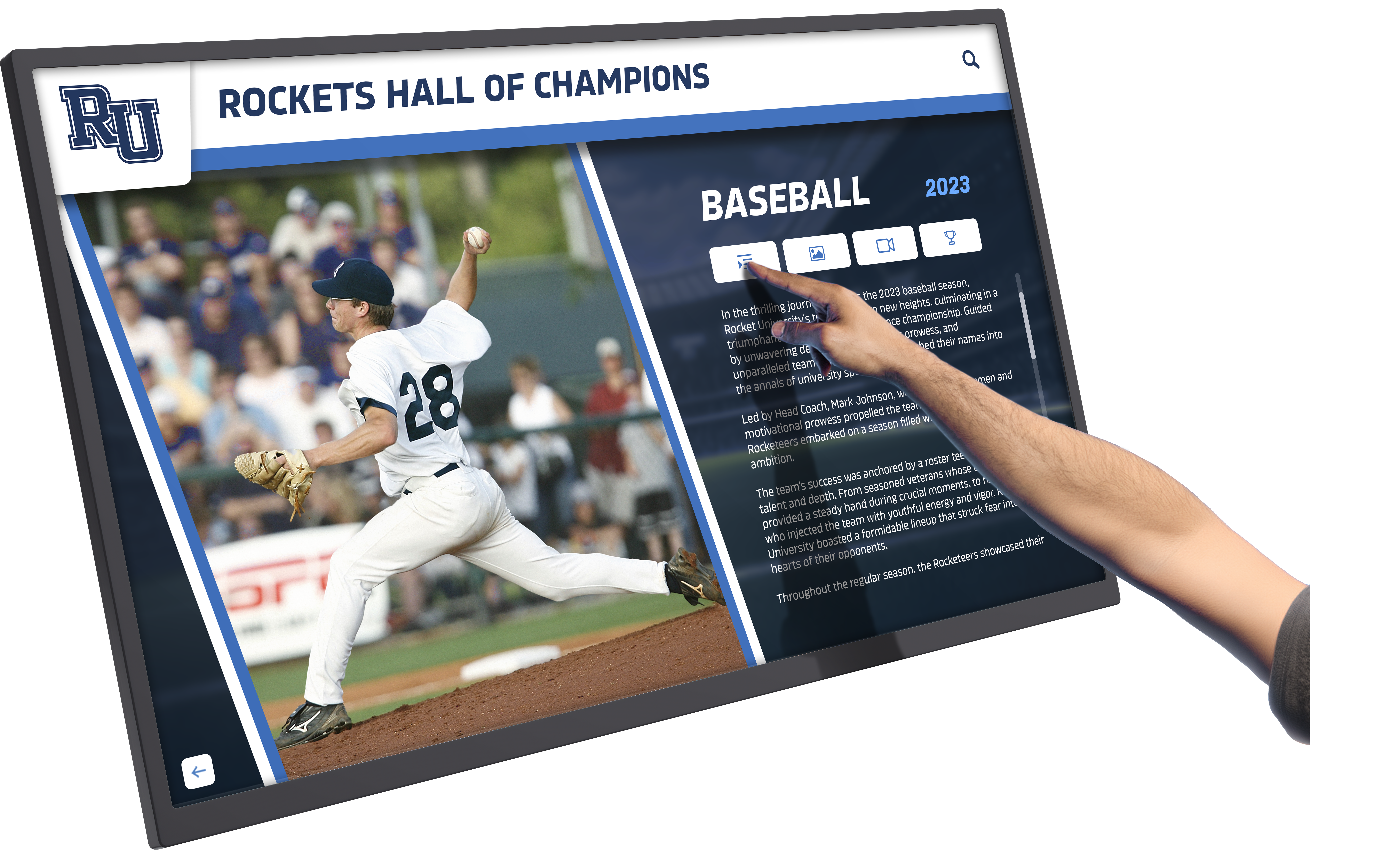
For programs with extensive championship histories, digital recognition proves essential for comprehensive documentation. Athletic programs that have generated dozens of championships across multiple sports and decades can finally provide recognition proportional to achievement scope rather than accepting arbitrary limitations imposed by ceiling space.
Rich Multimedia Storytelling
Digital banner recognition extends far beyond the minimal information traditional banners can display. Each championship in a digital system can include comprehensive details that tell complete stories:
Complete Team Information:
- Full roster with player names, numbers, positions, and class years
- Coaching staff including head coaches and assistants
- Team photos from championship seasons
- Individual athlete photos when available
- Statistical leaders and performance highlights
- Awards and honors earned by team members
Season Documentation:
- Complete game-by-game results and scores
- Overall record and winning percentage
- Playoff bracket progression and results
- Championship game details and highlights
- Notable victories and defining moments
- Season statistics and team records
Multimedia Content:
- Championship game video highlights
- Team celebration photos and videos
- Newspaper clippings and media coverage
- Coach and player interview clips
- Historical context and significance
- Alumni updates and career paths
This multimedia richness creates engagement that traditional banners cannot match. Instead of glancing at a banner listing basic achievement details, viewers can explore complete championship stories, watch game-winning plays, read detailed statistics, and understand what made specific seasons special.
Interactive Exploration and Searchability
Perhaps the most transformative aspect of digital banner recognition is interactivity. Traditional banners provide passive viewing experiences—viewers look up, read basic information, and move on. Digital recognition displays create active exploration that holds attention and enables personal discovery.
Name-Based Searching: Alumni visiting campus can search their own names to instantly find every championship team they participated in, complete with team photos, rosters, and season details. This personal connection proves impossible with traditional banners showing only years and achievement levels.
Sport-Specific Browsing: Visitors can filter championships by specific sports to explore complete program histories. A former volleyball player can view every volleyball championship in school history, understanding program traditions and comparing different championship eras.
Chronological Navigation: Users can browse championships by decade or era, exploring how programs evolved over time. This temporal organization helps contextualize achievements within broader institutional athletic history.
Achievement Level Filtering: Digital systems allow filtering by championship significance—state championships, conference titles, regional tournaments, or national competitions—helping viewers understand achievement hierarchies and program success at different competitive levels.
This searchability and interactivity fundamentally changes how people engage with championship recognition. Schools implementing interactive systems report that visitors spend 5-10 minutes exploring championship content compared to 30 seconds viewing traditional banner displays. This extended engagement creates stronger emotional connections and more meaningful recognition experiences.
Strategic Implementation: Combining Traditional and Digital Recognition
Most successful championship recognition programs don’t abandon traditional banners entirely. Instead, they implement hybrid approaches that leverage the strengths of both traditional and digital recognition methods.

Maintaining Physical Banner Presence
Traditional championship banners serve important functions that digital systems don’t replicate. Physical banners create immediate visual impact when entering gymnasiums, providing tangible evidence of athletic excellence visible during games and events. The overhead display location ensures maximum visibility during competitions when facilities are most active and audiences are largest.
Many schools maintain traditional banners for the most prestigious achievements—state championships, national titles, and historically significant accomplishments—while using digital systems for comprehensive recognition of all championships including conference titles, regional tournaments, and other important achievements that might not warrant individual physical banners due to space limitations.
This selective physical display approach preserves the ceremonial and traditional aspects of championship banners while digital systems ensure complete recognition for every championship team regardless of achievement level or era.
Strategic Digital Display Placement
Digital banner recognition displays maximize effectiveness through strategic facility placement that complements rather than competes with traditional banner displays.
Athletic Facility Entrances: Positioning interactive displays at main gymnasium or fieldhouse entrances ensures all visitors encounter comprehensive championship recognition upon arrival. This placement captures high traffic volumes while providing comfortable viewing environments where people can spend time exploring content without obstructing event activities.
Athletic Hallways and Corridors: Dedicated athletics recognition areas in hallways connecting locker rooms, training facilities, and competition venues create focal points for championship exploration. These locations serve current athletes who pass daily, reinforcing program traditions and providing ongoing inspiration throughout seasons.
Lobby and Common Areas: Multi-purpose spaces where athletes, families, and visitors gather before and after events provide extended viewing opportunities. Digital displays in these locations serve dual functions—engaging waiting visitors and creating conversation focal points during gatherings.
Training Facilities: Locating championship recognition displays within strength and conditioning facilities or practice venues ensures daily visibility for current athletes. This placement keeps championship traditions and program expectations continuously visible during preparation that leads to future achievements.
Complementary Content Strategy
The most effective hybrid recognition programs carefully coordinate content between traditional banners and digital displays, ensuring they enhance rather than duplicate each other.
Traditional physical banners continue to serve their core function: providing immediate visual recognition of championship achievements with maximum visibility during events. These banners maintain simplicity—sport, year, championship level—creating clean, consistent displays that work well from viewing distances and during active facility use.
Digital systems provide everything traditional banners cannot: complete rosters documenting every athlete who contributed to championships, detailed statistics and season records, multimedia content including photos and videos, searchable databases enabling personal exploration, historical context explaining championship significance, and ongoing updates as alumni careers develop.
This complementary approach means visitors receive both immediate visual recognition through traditional banners and the ability to explore detailed championship stories through digital systems. The traditional banners serve as “table of contents” highlighting major achievements, while digital displays function as comprehensive championship encyclopedias documenting complete program histories.
Enhancing Recruiting Through Digital Banner Recognition
Championship recognition serves critical recruiting functions, providing tangible evidence of program excellence and competitive traditions that attract prospective student-athletes. Digital banner recognition enhances recruiting effectiveness in ways traditional banners cannot match.
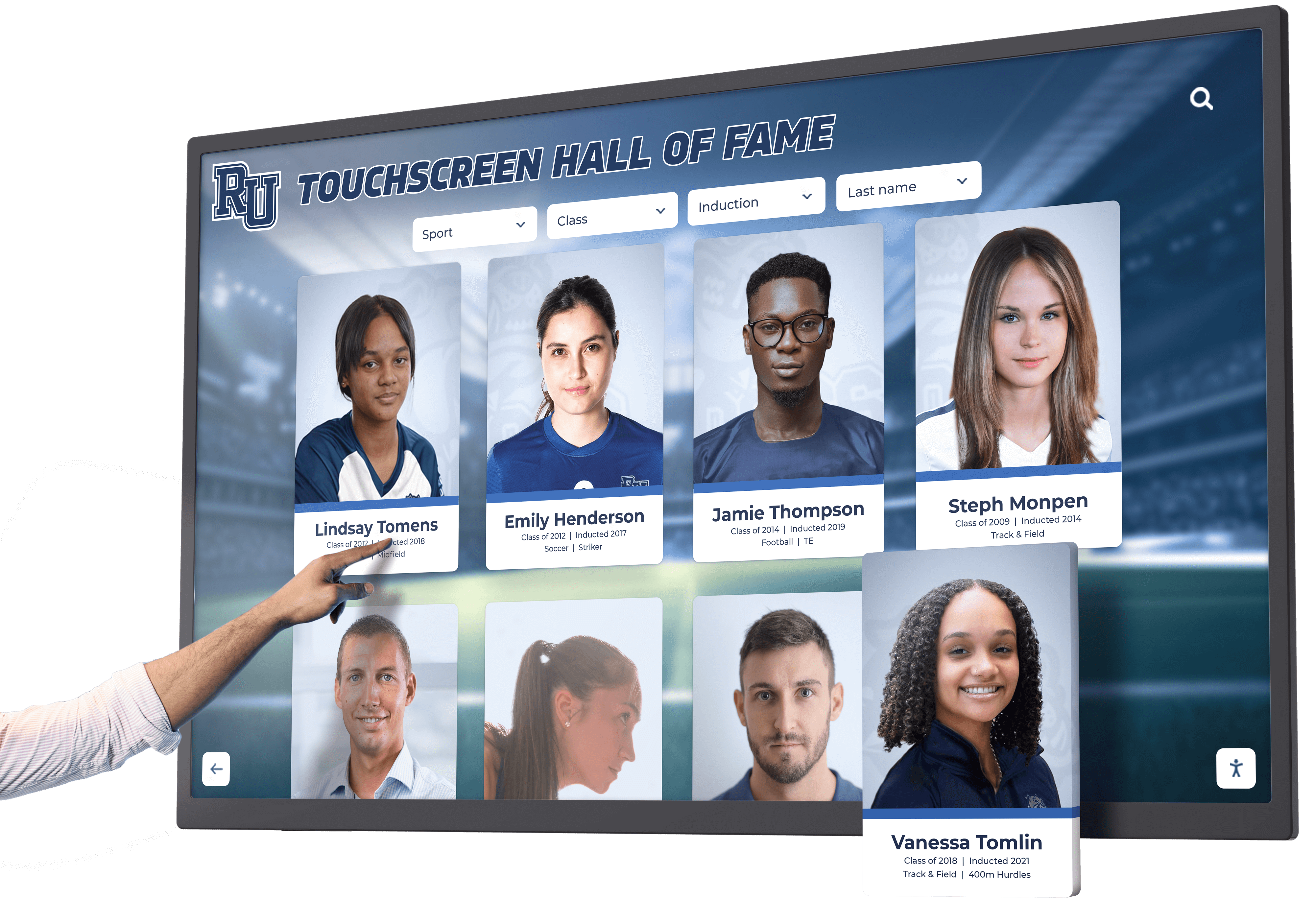
Comprehensive Program Excellence Documentation
Prospective athletes and their families evaluate programs based on competitive success, development track records, and championship traditions. While traditional banners provide overview impressions of program success, digital systems enable recruits to explore detailed evidence supporting program quality claims.
Recruits can review championship frequencies and consistency, examine complete team rosters identifying player positions and roles, analyze statistical performance patterns from championship teams, understand playoff performance and tournament success rates, and explore post-high school athletic careers of program alumni. This detailed exploration helps recruits make informed decisions about program fit and competitive opportunity.
Many coaches report that digital championship displays become standard recruiting visit stops where they can demonstrate program traditions through interactive exploration rather than simply pointing at overhead banners and providing verbal summaries. The ability to show rather than tell championship stories creates stronger impressions during competitive recruiting battles.
Position-Specific Recognition
Digital championship recognition enables position-specific recruiting narratives that traditional banners cannot support. Coaches recruiting quarterbacks can showcase every championship quarterback throughout program history, complete with statistics, awards, and college football careers. Volleyball coaches can demonstrate libero development through comprehensive recognition of defensive specialists from championship teams across decades.
This position-specific recognition helps recruits envision themselves within program contexts and understand development pathways from freshmen to championship contributors. Digital systems can filter and organize content in ways that directly address recruit questions about playing time progression, position competition, and development opportunities.
Family Engagement and Decision Support
Athletic recruiting involves entire families, with parents often driving final decisions about school selection. Digital championship displays engage parents by providing comprehensive information that addresses common parental concerns about program quality, coaching stability, academic emphasis, and post-high school outcomes.
Parents can explore academic achievements of championship teams, review coaching tenure and program stability evidence, understand alumni career paths and college athletics participation, and see recognition of diverse contributions beyond star athletes. This comprehensive information helps families feel confident about program quality and student-athlete welfare priorities.
Schools implementing digital recognition systems report that recruiting visit durations at championship displays often extend beyond planned schedules as families discover additional content of interest. This extended engagement correlates with higher conversion rates from visits to commitments.
Building School Pride and Community Connection
Championship banners serve broader purposes beyond athlete recognition and recruiting. They build school pride, strengthen community identity, and create visible connections between current students and institutional traditions. Digital banner recognition amplifies these community-building functions.
Engaging Current Students
Traditional championship banners hang far overhead in gymnasiums, creating physical and perceptual distance between current students and past achievements. Digital recognition displays bring championships to accessible, interactive formats that current students can explore and connect with personally.
Students can search for older siblings, parents, or relatives who appear in championship team rosters, creating family connections to school athletic traditions. They can explore championships from years they’ve heard about in stories, understanding what made those seasons significant. They can compare current team statistics and performance with championship team benchmarks, setting goals and aspirational targets.

This accessibility makes championship history relevant rather than distant. When students can interact with and explore championship recognition rather than passively viewing overhead banners, achievements become part of ongoing school experience rather than historical facts disconnected from current reality.
Strengthening Alumni Engagement
Championship recognition creates powerful alumni engagement opportunities when implemented through searchable digital systems. Alumni can locate themselves within complete team rosters, share championship team photos through social media, revisit championship game highlights and memorable moments, and update schools with career information for incorporation into championship profiles.
This engagement extends well beyond graduation. Alumni visiting campus for games, reunions, or other events regularly spend extended time exploring digital recognition displays, searching for their teams, and sharing discoveries with family members and former teammates. Schools report that digital championship displays generate social media content as alumni photograph screens showing their achievements and share through personal networks.
The searchability of digital systems proves particularly valuable for alumni engagement. Rather than asking alumni to scan dozens of overhead banners hoping to spot years they competed, digital search functionality enables instant discovery of relevant content, creating positive recognition experiences that strengthen ongoing institutional connections.
Supporting Development and Fundraising
Athletic recognition serves institutional advancement by engaging alumni emotionally with programs and creating donation motivation. When alumni can explore comprehensive championship recognition documenting their contributions and relive meaningful competitive experiences, emotional connections strengthen—connections that often translate to philanthropic support.
Many schools integrate championship recognition with naming opportunities and donor recognition, allowing championship team alumni to contribute toward recognition displays, facility improvements, or program scholarships. The emotional resonance of championship memories combined with convenient digital engagement creates natural fundraising opportunities.
Additionally, comprehensive championship documentation demonstrates program excellence to prospective donors who may not have direct athletic connections. The evidence of sustained success, community engagement, and values-driven athletics programs appeals to donors interested in supporting competitive excellence and student development.
Practical Implementation Considerations
Schools considering digital banner recognition implementation benefit from understanding technical requirements, content development approaches, and ongoing management considerations.
Technology Selection and Hardware
Digital banner recognition requires two core components: commercial-grade display hardware and purpose-built recognition software. Hardware selection depends on viewing distance, traffic levels, and facility characteristics.
Display Size and Type: Locations with close viewing distances (6-10 feet) work well with 43-55 inch touchscreens. High-traffic areas with group viewing benefit from 65-75 inch displays. Commercial-grade screens designed for continuous operation ensure reliability in public spaces with operational lifespans of 50,000-70,000 hours before requiring component replacement.
Mounting Options: Wall-mounted displays create clean installations when suitable wall space exists at appropriate heights. Freestanding kiosks provide flexibility for locations without suitable walls or requiring mobile configurations. Custom enclosures can integrate displays into architectural features or branded installations.
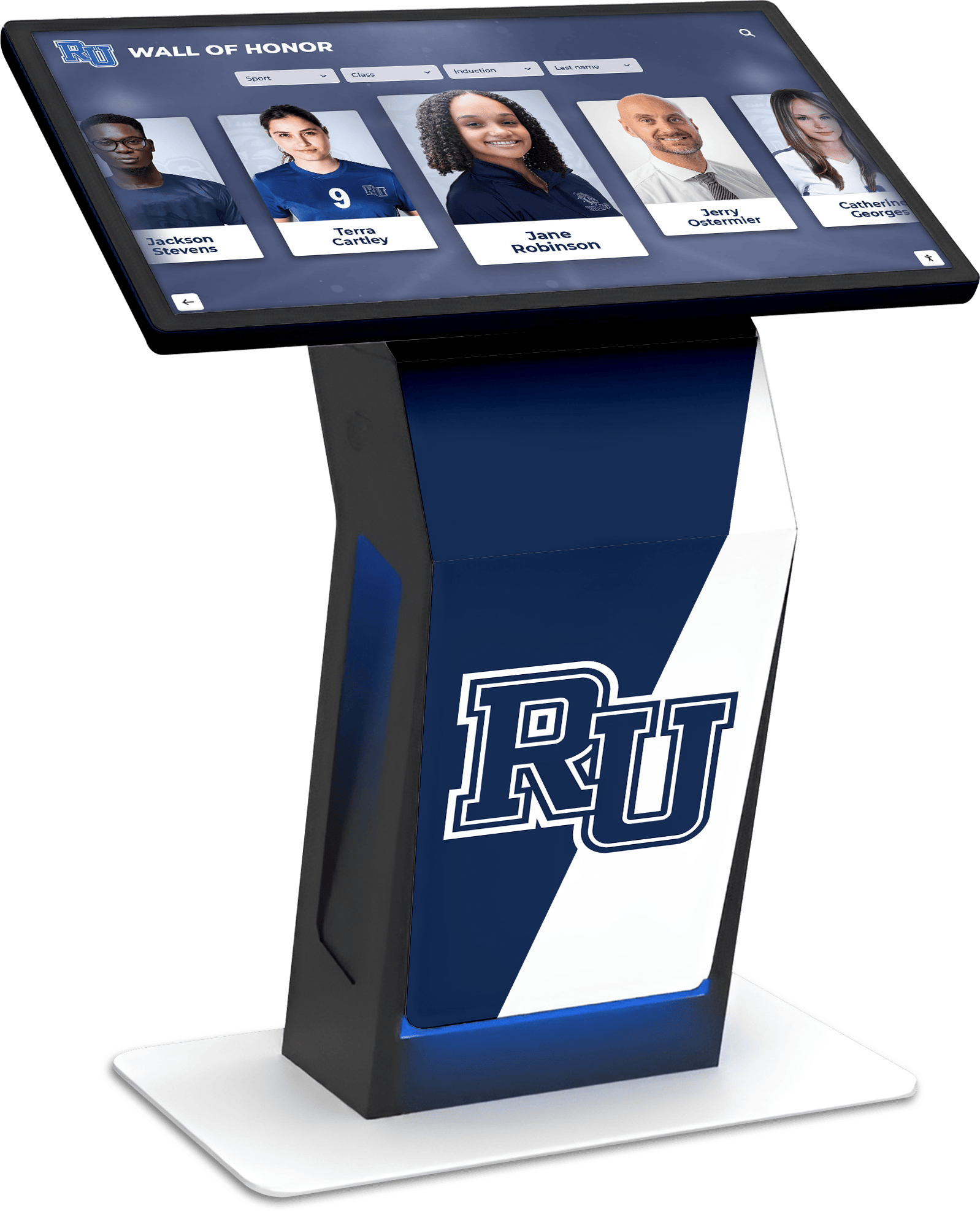
Network Connectivity: Digital recognition systems require internet connectivity for content management and updates. Wired Ethernet connections provide reliability when available. Secure WiFi networks serve locations where wired connections prove impractical. Most systems cache content locally, allowing continued operation during temporary connectivity interruptions.
Software Platform Requirements
Purpose-built recognition platforms designed specifically for educational institutions offer significant advantages over generic digital signage systems or custom development. Specialized platforms like Rocket Alumni Solutions include features specifically addressing school championship recognition needs:
- Intuitive content management requiring no technical expertise
- Pre-designed templates for consistent championship profiles
- Search and filtering features optimized for athletic recognition
- Multimedia support for photos, videos, and documents
- Cloud-based access enabling remote content management
- Analytics tracking engagement and popular content
- Mobile responsiveness for personal device access
- Ongoing platform updates and improvements
Generic alternatives may appear cost-effective initially but typically require more implementation effort, ongoing technical maintenance, and compromises on recognition-specific features that specialized platforms provide.
Content Development Strategy
Comprehensive digital banner recognition requires systematic content development documenting championship histories. Schools benefit from phased approaches that enable earlier launches while building complete historical content over time.
Priority Content (Phase 1): Begin with recent championships from the past 5-10 years, focusing on major achievements like state championships, significant tournament victories, and milestone accomplishments. Include complete team rosters, season records, basic statistics, and championship game details. This initial content provides sufficient depth for meaningful displays while keeping implementation timelines manageable.
Comprehensive Current Coverage (Phase 2): Expand to complete documentation of all current sports programs regardless of recent championship success, demonstrating equitable recognition across all athletics. Include conference championships, tournament participations, and program achievements beyond major titles. This phase showcases system capacity for comprehensive recognition rather than only highlighting traditional powerhouse programs.
Historical Documentation (Phase 3): Systematically work backward through school history, adding championships by sport, decade, or era. Engage alumni associations, local historians, and community members in gathering historical photos, rosters, and achievement documentation. Break this historical work into manageable projects distributed over months or years rather than delaying implementation until complete historical documentation exists.
Measuring Success and Impact
Schools investing in digital banner recognition benefit from understanding how to evaluate program effectiveness and maximize return on investment.
Engagement Metrics
Digital systems provide analytics revealing how visitors interact with championship content:
- Display interaction frequency and duration
- Most-viewed championships and content types
- Search patterns and filtering preferences
- Peak usage times and traffic patterns
- Return visitor rates indicating ongoing interest
- Popular content types (photos, videos, statistics)
- Geographic access patterns for web-based systems
These metrics guide content development priorities, inform decisions about additional display locations, and demonstrate recognition program value to administrators and stakeholders.

Program Outcomes
Beyond quantitative engagement metrics, schools should assess qualitative outcomes:
Athlete Impact: Do current athletes reference championship displays during goal-setting conversations? Do teams use historical achievements as motivation and benchmarks? Are younger athletes aware of program traditions and championship histories in ways they weren’t before digital recognition implementation?
Recruiting Effectiveness: Do prospective athletes and families comment on championship recognition during visits? Does championship content appear in recruiting communications and conversations? Do coaches report that comprehensive championship documentation strengthens recruiting narratives and competitive positioning?
Alumni Connections: Has reunion attendance increased, particularly for championship teams? Do alumni share championship content through social media and personal networks? Have alumni contributions increased following digital recognition implementation, particularly from championship team members?
Community Engagement: Do local media reference championship recognition in features about athletic programs? Has community attendance at athletic events increased following comprehensive championship celebration? Do community members engage with recognition displays during facility visits?
Return on Investment
Financial ROI considerations include both direct costs and broader value creation. Direct costs include initial hardware and software investment ($10,000-$30,000 typically for single-display systems), annual software licensing and support ($1,500-$4,000), and content development time (initial investment of 40-80 hours, ongoing updates minimal).
Value creation includes avoided costs for physical banner expansion and replacement, enhanced recruiting competitiveness and prospective athlete attraction, increased alumni engagement supporting development goals, preserved championship documentation more durably than physical artifacts, and improved space utilization through compact display footprints.
Many schools report that investments achieve break-even within 3-5 years while providing capabilities physical banners alone cannot deliver. When viewed as long-term infrastructure investments similar to scoreboards or facility improvements, digital championship recognition delivers strong returns across operational efficiency, stakeholder engagement, and program promotion dimensions.
Future Directions for Championship Recognition
Digital banner recognition continues evolving as technologies advance and schools discover innovative applications for interactive championship celebration.
Emerging Technologies
Several technologies promise to enhance digital championship recognition in coming years:
Artificial Intelligence Integration: AI-powered search could enable natural language queries like “Show me all basketball championships from the 1990s” or “Find championships featuring players who went on to college athletics.” Automated content generation might draft achievement narratives from structured data, and computer vision could automatically tag photos and videos with player identifications and game situations.
Augmented Reality Features: AR applications could allow visitors to point smartphones at traditional physical banners to access overlaid digital content—team rosters, statistics, video highlights, or alumni updates. Virtual banner galleries might display all championships regardless of physical hanging space, with interactive exploration in mixed reality environments.
Social Media Integration: Enhanced sharing features could automatically generate championship celebration graphics optimized for various social platforms. Integration with alumni networks might enable direct messaging between current athletes and championship alumni for mentoring connections.
While these advanced features generate excitement, schools should prioritize solid execution of core recognition functions before pursuing emerging capabilities. The foundation of comprehensive championship documentation and intuitive user experience matters more than technological sophistication.
Conclusion: Honoring Every Championship
Championship banners represent significant achievements worthy of comprehensive recognition that extends beyond the minimal information traditional fabric banners can display. Every championship team includes dozens of student-athletes whose contributions deserve documentation. Every championship season involves memorable moments, defining victories, and inspiring performances that create program legacies. Every championship builds school traditions that connect current students to institutional excellence.
Digital banner recognition ensures that championship celebration matches achievement significance. By combining traditional physical banners maintaining ceremonial prominence with interactive digital systems providing comprehensive documentation, schools honor championships completely while creating engagement opportunities that inspire current athletes, strengthen alumni connections, and build community pride around athletic excellence.
Whether addressing practical constraints of limited banner hanging space, seeking enhanced recruiting effectiveness through comprehensive championship documentation, or simply wanting to honor athletic achievement more thoroughly, digital banner recognition solutions provide practical, engaging approaches that serve entire school communities.
The evolution from space-constrained physical banners to unlimited-capacity digital platforms represents more than technology adoption—it represents commitment to recognizing every championship appropriately, preserving every moment of athletic excellence, and ensuring that decades of competitive achievement remain visible and valued for generations to come.
Ready to transform how your school celebrates championship achievement? Solutions like Rocket Alumni Solutions provide comprehensive platforms specifically designed for school athletics recognition, combining intuitive content management, engaging user experiences, and ongoing support ensuring long-term success. Every championship deserves complete recognition—not just those fitting limited physical space.
